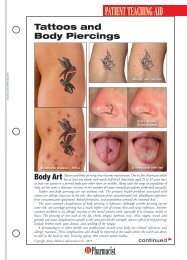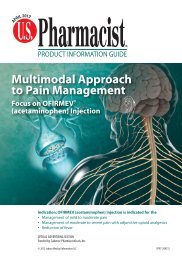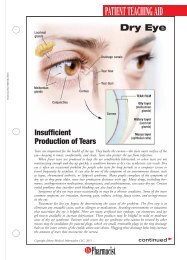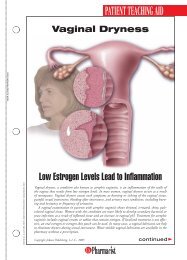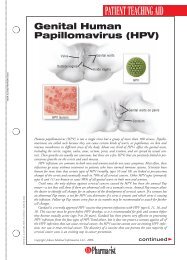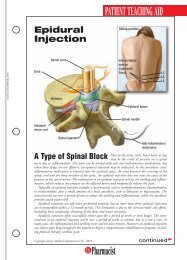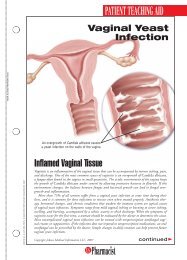View PDF Edition - U.S. Pharmacist
View PDF Edition - U.S. Pharmacist
View PDF Edition - U.S. Pharmacist
Create successful ePaper yourself
Turn your PDF publications into a flip-book with our unique Google optimized e-Paper software.
Fentanyl transdermal system shouldONLY be used in patients who are alreadyreceiving opioid therapy, who havedemonstrated opioid tolerance, andwho require a total daily dose at leastequivalent to fentanyl transdermal system25 mcg/hr. Patients who are consideredopioid-tolerant are those who have beentaking, for a week or longer, at least 60 mgof morphine daily, or at least 30 mg of oraloxycodone daily, or at least 8 mg of oralhydromorphone daily or an equianalgesicdose of another opioid.Because serious or life-threateninghypoventilation could occur, fentanyltransdermal system is contraindicated:• in patients who are not opioid-tolerant• in the management of acute pain or inpatients who require opioid analgesiafor a short period of time• in the management of postoperativepain, including use after out patientor day surgeries (e.g., tonsillectomies)• in the management of mild pain• in the management of intermittentpain [e.g., use on an as needed basis(prn)]The safety of fentanyl transdermal systemhas not been established in children under2 years of age. Fentanyl transdermalsystem should be administered to childrenonly if they are opioid-tolerant and 2 yearsof age or older (see PRECAUTIONS:Pediatric Use).Patients using fentanyl transdermal systemshould avoid exposure to external heatsources, such as heating pads, hot tubs,long hot baths, and sunbathing. An increasein body temperature may result in a suddenand possible dangerous rise in their bodyfentanyl level. Fentanyl transdermalsystem may cause death from overdosage;therefore, it is important for healthcareprofessionals, patients and caregivers toknow the signs of fentanyl overdose, whichcan include trouble breathing and extremesleepiness. Fentanyl transdermal systemshould be stored in a safe place andkept out of the reach of children. Used,unneeded or defective fentanyl patchesshould be safely disposed of by foldingthe sticky side of the patch together(until it sticks to itself) and flushing itdown the toilet.The most common adverse events reportedin clinical trials were fever, nausea, vomiting,constipation, dry mouth, somnolence,confusion, asthenia, and sweating.Please see adjacent Brief Summaryof Prescribing Information, includingBOXED WARNING.In the management of persistent, moderate to severe chronic pain that requirescontinuous, around-the-clock opioid administration foran extended period of time and cannot be managed by other means*Why Take A Chance WithOther Fentanyl Patches?One patch can cause burns.This matrix patch contains aluminum in its backing, which canoverheat during a magnetic resonance imaging (MRI) scan andburn the patient who is wearing it.Other patches can leak.They contain a reservoir of fentanyl gel that can leak and causepotentially life-threatening complications.Mylan FENTANYL is the first marketedfentanyl patch designed to avoid therisks associated with burns and leaks.The Mylan FENTANYL TRANSDERMALSYSTEM C II has no aluminum or othermetals in its backing. Also importantto patient safety, Mylan Fentanyl has aproprietary matrix design without aliquid, gel-filled reservoir that can leak.It is an innovative solution in transdermaldrug delivery.*Other means include non-steroidal analgesics, opioid combination products, or immediate-release opioids.©2009 Mylan Pharmaceuticals Inc. MYNFEN031No metal. No burns. No leaks.




